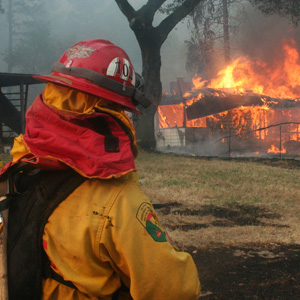800,000 will be getting billed to help fight wildfires
By Alice Daniel

It’s fire season in California. The blazes may not be big enough to draw national TV news crews, but pulling from the top of CAL FIRE’s news feed it’s easy to see the agency is busy.
There’s the Volcano Fire in Riverside County, the Salt Creek Fire in Shasta, the Graham Fire in Tuolumne. Demand for services is as big as it’s ever been, but CAL FIRE has not been spared from budget cuts, which explains a new bill that roughly 800,000 rural homeowners, those who live in the most fire-prone areas, will soon have to pay.
The legislature-approved fee is up to $150 per home and should generate $84 million per year, says CAL FIRE spokesperson Daniel Berlant.
“All that money will go towards fire prevention in the state responsibility area,” Berlant said. “The most notable activities include brush clearance, forest health, fuel reduction.”
A recent state report on climate change says hotter temperatures already are causing more and larger fires. Berlant says 11 of the top 20 largest fires recorded in California have occurred in the past decade. “Even this year, we’ve seen about twice as many fires as we did last year. And that does have us concerned and does have us very busy this year,” said Berlant.
They’re doing it with less money — CAL FIRE’s budget has been slashed in recent years. “CAL FIRE has taken some major budget reductions over the past couple of years. Almost $80 million in the last year-and-a-half, including to seasonal firefighters,” said Berlant. We’ve reduced the number of firefighters on an engine, we’ve closed one of our air tanker bases.
There is some opposition to the fee. The Howard Jarvis Taxpayers Association contends that it is an illegal tax. It says it will sue the state to have the charges refunded. Meanwhile the bills are slated to go out between now and December.
4 thoughts on “Rural Californians: Get Ready to Pay for Fire Protection”
Comments are closed.


That is not Cal Fire News Feed! California Fire news existed before CDF changed their name!
CAL FIRE NEWS * CALIFORNIA FIRE NEWS
calfire.blogspot.
Would be curious if they asked you for the hot link? If so then they are practicing restraint of trade! I request removal of the incorrect hot link!
No one requested this link. It connects to the official CAL FIRE website, as was our intent.
Unfortunately, this is media politcial spin by the very agency I work for! They can’t scientifically connect the possible global warming issue with the largest fires because the actual temp change has very little to do with the size of a fire. There are other issues that created these large fires that had nothing to do with Global Warming. They are also being sneaky when they say the number of fires is twice as many as last year. Last year was an incredibly slow year due to much higher than normal precip and a longer wet winter. They can pick and choose their stats to try and beef up their desire for more money, but the facts are that none of tax increase (that is what it is) are earmarked to go towards firefighting. They won’t replace the firefighter they took off the engines, it won’t reopen the tanker base, it doesn’t buy more equipment, etc… The money is to be used for Governor Brown’s feel good stuff like urban tree planting grants and Smokey Bear education programs. This is nothing more than a money grab by the legislature and the Governor’s office and they are framing CalFire to look like the bad guy. I honestly don’t know how Berlant can do his PIO job without crying at this point.
Lassen Community College, up in the Susanville area in Northeastern California, includes a Fire Technology program in its curriculum – it’s essentially fire fighting training. One of the best ways the proposed fee could be used for is to hire young people, especially students to this and other like programs such as horticulture, across the State, to perform wildfire clearance, especially in the park system regardless of their respective source funding. What this work includes is removing lower branches of soft woods, shaping hardwood varieties, pulling up dead brush, raking debris away from the base of trees – fire goes to where there is fuel; if there is no fuel at the trees’ bases then that should help reduce wildfire spread through the tree tops and through the roots, and removal of the debris. The paid work supports the students’ effort to higher education and injects positive growth in local economies.
Because this prevention program would have to be state-wide, it would have to be administered at a state-level. One way to avoid the waste of legal injunctions forced upon residents by the ignorance of anti-tax organizations, would be to have homeowners donate those fees to their local colleges that offer these programs. That would create a tax-deduction for the home owners, but still provide the necessary financial support for those students that would in the long run prevent the loss of untold billions of dollars in loss of lives, both publicly and privately owned property, and the loss of tourist revenue that makes this State strong.